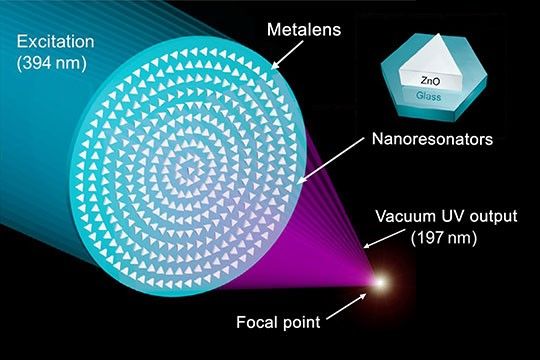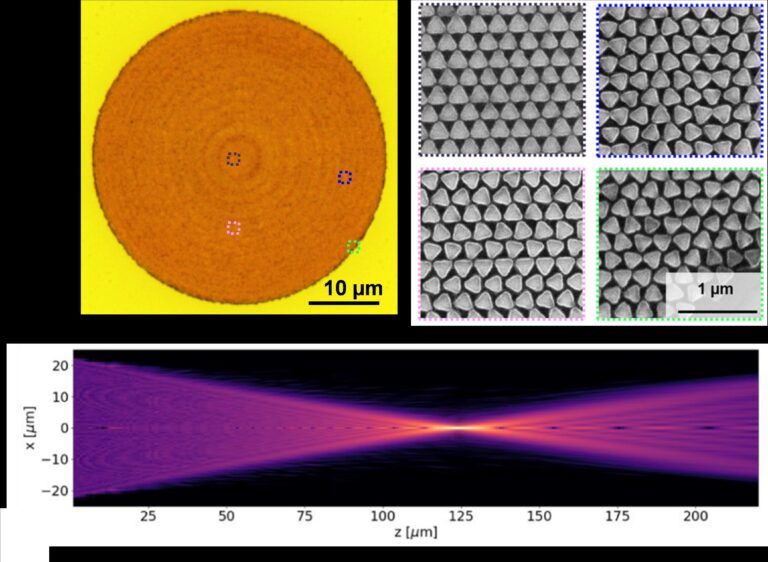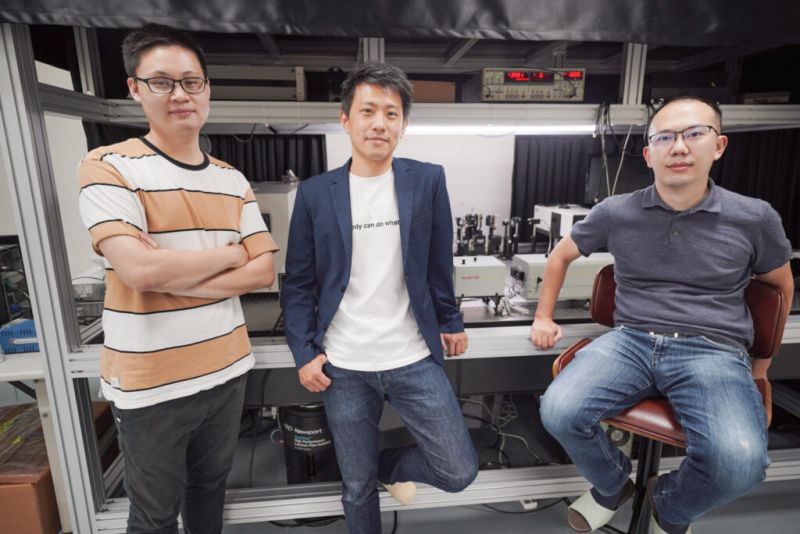媒體報導
2022-06-29 13:53:20Patty ChenNational Yang Ming Chiao Tung University cooperates with multinational teams to develop vacuum ultra
Ultraviolet light is highly useful for sterilization, decontamination, green energy generation, quantum computing, and advanced lithography. However, it is not easy to effectively generate and control ultraviolet light. Dr. Ming-Lun Tseng, an assistant professor of the Institute of Electronics, has cooperated with research teams from Rice University (USA), City University of Hong Kong, National United University, and Academia Sinica, to develop a nanoscale metasurface lens (also known as Metalens) that is capable of effectively generating and focusing ultraviolet light. The research results were published in a scientific journal "Science Advances".

Vacuum Ultraviolet Metalens. Under irradiation of a visible light laser, metalens generates and focuses vacuum ultraviolet light through its designed nonlinear effect.
Dr. Ming-Lun Tseng said the research focuses on modulating vacuum ultraviolet light (VUV light) by using nanotechnology. Compared with ordinary visible light, vacuum ultraviolet light has higher photon energy and can only exist in vacuum. VUV light plays an important role in the development of next-generation technologies for photochemistry, material analysis, lithography, etc. However, generating and controlling VUV light have always been challenging as general optical materials strongly absorb it. For decades, this issue has severely limits scientists to further explore the undiscovered applications of VUV light.
To solve the long-standing problem for VUV technologies and realize novel VUV devices, Dr. Tseng decided to use a different approach which is based on so-called metasurface photonics. Metasurfaces are artificial nanostructures containing a lot of carefully designed nanoantennas with assigned optical properties. The functionalities of metasurfaces, such as light generation and focusing, can be designed by tuning the geometric parameters of the nanoantennas inside. Metalenses are specialized metasurfaces for light focusing and imaging. Compared with conventional thick glass lenses, metalenses are not only ultracompact and lightweight, but also show many exotic properties which are key for applications such as virtual reality devices, quantum optics, and clinical imaging.
 Results for vacuum ultraviolet metalens. Top left: Optical microscopic image of the metalens. Top right: Scanning electron microscopic images of the nanoantennas at the highlighted boxes in the optical image. Bottom: Focusing analysis results of metalens.
Results for vacuum ultraviolet metalens. Top left: Optical microscopic image of the metalens. Top right: Scanning electron microscopic images of the nanoantennas at the highlighted boxes in the optical image. Bottom: Focusing analysis results of metalens.
The reported VUV metalens is made of semiconductor material zinc oxide (ZnO). In their preliminary research, the team found that under the irradiation of a visible light laser, nanostructured zinc oxide can convert visible light into vacuum ultraviolet light. This phenomenon is called second harmonic generation, which is a key technology often used in laser devices and bioimaging instruments. To realize the VUV generating metalens, the team found that several parameters need to be considered for designing the nanoantennas in the metalens, including the constituent materials, optical properties, and the geometry.
After combining the theory of quantum physics, nonlinear optics, and nano-photonics, Dr. Ming-Lun Tseng and the team members decided to use zinc oxide triangular nanoantennas as the unit cells in the metalenses. They used electron beam lithography and focused ion beam milling techniques to make several metalenses. In the measurement at Rice University, they observed metalenses successfully converted the incident visible laser into VUV light and focused it in free space. The size of the focused VUV spot generated by the metalens is only about two micrometers (less the general widths of hairs). Compared with the unfocused VUV plane wave, the intensity density of VUV light at the focusing spot is significantly enhanced by a factor of 21. The novel property of the reported metalens shows the potential for its integration into advanced spectroscopic studies.
 Assistant Professor Ming-Lun Tseng’ (middle) research teamed up with various international research teams to develop a novel vacuum ultraviolet metalens (Photo by Mr. Shih-Chieh Chen, NYCU).
Assistant Professor Ming-Lun Tseng’ (middle) research teamed up with various international research teams to develop a novel vacuum ultraviolet metalens (Photo by Mr. Shih-Chieh Chen, NYCU).
The research team expects that in the future, more metasurfaces will be realized due to their properties of being ultracompact and multifunctional. In addition, considering Taiwan's well-established semiconductor industry, the team is optimistic about the future of metalens research in Taiwan as they are made of semiconductor nanostructures that can be mass-produced by standard industry processes. When speaking of the outcome and the future of his research, Dr. Tseng especially thanks the support of the cooperation teams, the Ministry of Science and Technology, the Ministry of Education, and the Institute of Electronics. He said this is only the first step and he believes that in the future, metalenses will solve more long-standing technological problems and bring more important applications.
Paper link: https://www.science.org/doi/10.1126/sciadv.abn5644
Ming Lun Tseng, Michael Semmlinger, Ming Zhang, Catherine Arndt, Tzu-Ting Huang, Jian Yang, Hsin Yu Kuo, Vin-Cent Su, Mu Ku Chen, Cheng Hung Chu, Benjamin Cerjan, Din Ping Tsai, Peter Nordlander, Naomi J. Halas “Vacuum Ultraviolet Nonlinear Metalens.” Science Advances, 8, eabn5644 (2022).
Source:https://www.nycu.edu.tw/news/3703/

